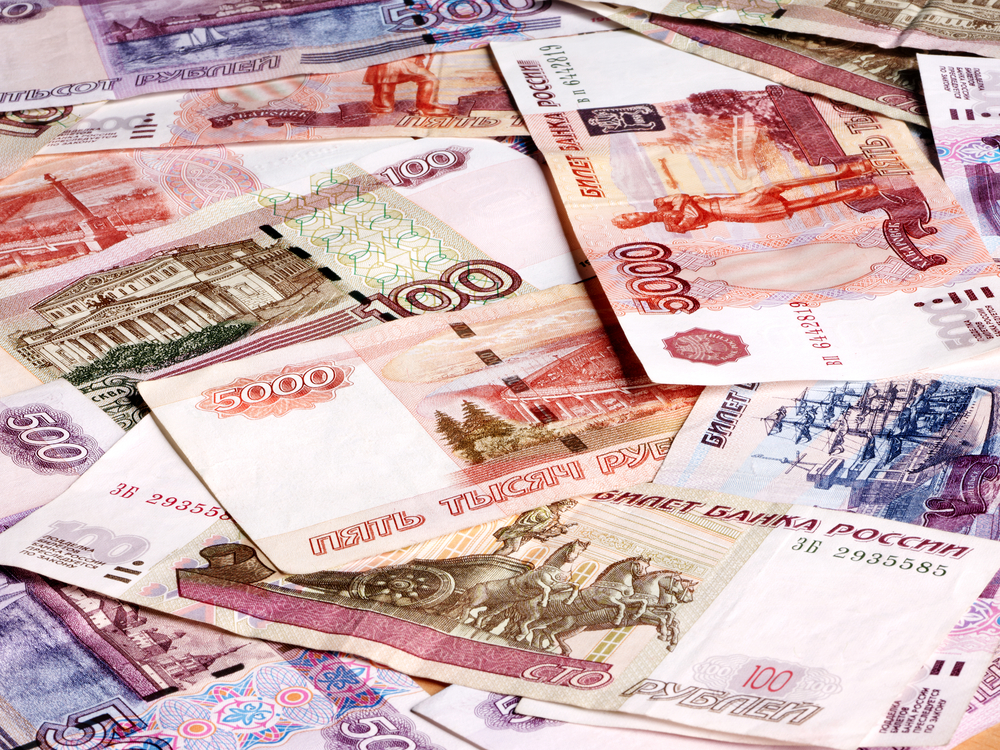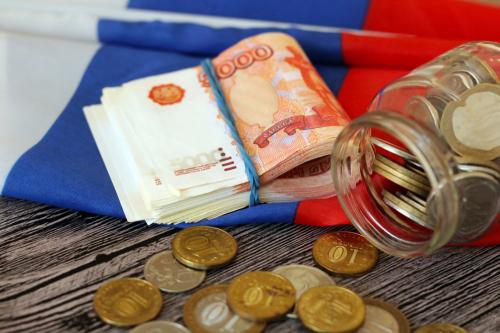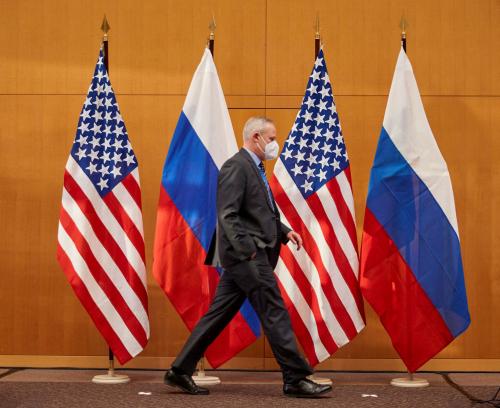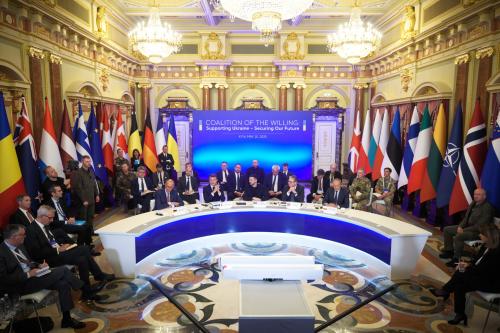This was originally published on March 18, 2024, and has since been updated to reflect ongoing developments. An April 2025 update is available here.
After Russia invaded Ukraine in February 2022, Russia’s foreign exchange reserves held by the U.S. and its allies were frozen. Since then, some officials and commentators have proposed seizing those assets, which amount to nearly $300 billion, and using the proceeds to defend and rebuild Ukraine. Russian reserves could provide Ukrainians much-needed support as the war drags into its third year. This policy is not without risk or controversy: Seizing foreign exchange reserves has little economic or legal precedent and uncertain long-run effects. This post explains the efforts to seize Russia’s reserves and the possible consequences for the global financial system.
What are foreign exchange reserves?
Foreign exchange reserves are assets of a central bank held in securities and deposits denominated in foreign currencies, usually government bonds issued by advanced economies or deposits in global banks. Central banks use reserves to facilitate international payments, manage exchange rates, and guarantee the value of the local currency. The International Monetary Fund (IMF) reports that nearly 80% of all foreign exchange reserves are held in the U.S. dollar or the euro.
Where are the Russian reserves?
On the eve of Russia’s invasion of Ukraine, the Central Bank of Russia (CBR) reported just under $500 billion in foreign exchange reserves, roughly $300 billion of which were denominated in U.S. dollars, euros, or British pounds.1 The Russian Elites, Proxies, and Oligarchs Task Force set up by the Group of Seven (G7), European Union (EU), and Australia estimated frozen Russian reserves at $280 billion in September 2023. Approximately $210 billion of these assets are held at Euroclear, a Belgian financial services company that specializes in holding and investing securities, on behalf of the CBR. The remaining frozen reserves are likely held in U.S. and allied countries’ banks, with about $5 billion being held in the U.S.
You can read more about Russia’s external position in an April 2024 post from the Hutchins Center.
Why is there a move to seize Russian reserves?
As of mid-February 2024, estimates show that the U.S. and allies have sent $280 billion to Ukraine in military, financial, and humanitarian aid. Seizing Russian reserves helps allied governments continue to support Ukraine by reducing the burden on taxpayers and making Russia foot the bill for its own aggression. Ukrainian President Volodymyr Zelensky has repeatedly urged allies to seize Russian reserves, saying in January 2024, “The more billions [Putin] and his oligarchs, friends, and accomplices lose, the more likely he will regret starting this war.” Finally, Russian reserves are appealing in their quantity; they would cover three-quarters of the cost of rebuilding Ukraine as estimated by the World Bank one year into the war. As former World Bank president Robert Zoellick writes, seizing reserves is “elegant justice” and a desperately needed infusion for Ukraine.
Where does the U.S. stand on seizure?
On April 24, 2024, President Biden signed legislation that incorporates the Rebuilding Economic Prosperity and Opportunity for Ukrainians Act (REPO Act), which empowers the President to seize Russian foreign exchange reserves within the U.S. after identifying reserves and reporting back to Congress within 180 days. Prior to this legislation, legal scholars disagreed about whether the President had authority to seize reserves in peacetime. U.S. officials, including Treasury Secretary Janet Yellen, indicated that the administration did not possess the authority to seize reserves without Congressional action.
Where do U.S. allies stand on seizure?
At the June 2024 G7 summit, leaders agreed to lend roughly $50 billion to Ukraine this year and use profits from investing frozen Russian central bank assets to gradually repay the loans. Financial institutions, primarily in Europe, are accumulating cash as the Russian-owned securities pay interest and mature. The G7 and EU plan to use the profits from investing these cash balances to pay down the loan. Most of the profit will come from Euroclear through an EU law passed in May 2024 which requires large securities depositories to hand over profits on reinvested Russian balances. Euroclear collected about $5 billion in such profits in 2023.
G7 leaders finalized the details of the loan agreement in October 2024 and began implementing the plan in December. The U.S. disbursed the agreed-upon $20 billion to Ukraine in mid-December through the World Bank. All $20 billion will be for economic assistance because Congress declined the Biden administration’s proposal to use half the balance for military aid. The EU signed an agreement with the Ukrainian government committing to $19 billion. Other G7 members are providing the remainder of the $50 billion target: Canada, the U.K., and Japan have announced each will contribute about $3 billion.
Most U.S. allies remain wary of seizing Russian assets directly. The U.K. has expressed support for seizure, although Italy, Germany, and France strongly question the legality and fear economic reprisal from Russia. Germany is especially worried that asset seizure could lend credence to ongoing World War II reparations claims against it. The European Commission began evaluating legal options to seize Russian assets in November 2022, but member states cannot reach an agreement, and the Commission indicates that it is unlikely to pursue outright seizure further. European Central Bank President Christine Lagarde warned: “Moving from freezing the assets, to confiscating them, to disposing of them is something that needs to be looked at very carefully.” Seizure could “break the international order that you want to protect; that you would want Russia and all countries around the world to respect,” she added.
What are the international legal hurdles to seizing Russian reserves?
Advocates for seizure argue that Russia’s assets can be seized under the international law of countermeasures, which provides nations a pathway to implement certain otherwise unlawful remedies in proportional response to the unlawful actions of another state. But many officials and legal scholars argue that there is no precedent, and asset seizure is inconsistent with conventional understandings of how countermeasures should operate, including that they be reversible and primarily implemented by directly affected states.
Furthermore, reserves generally receive the strongest sovereign immunity protections; nations need confidence that their property rights will be honored under international law to participate in the global economy. Russia’s abhorrent, unlawful aggression in Ukraine may well disqualify them from enjoying reserve protections, but many nations will wonder what exactly the limits are if seizure becomes permissible. University of Virginia Professor Paul Stephan argues that “a transparent violation of a category of rules that the U.S. normally supports, simply because compliance would frustrate an immediate sense of justice, undermines the ability to use international law to shape a more peaceful and prosperous world.” Russia is already planning to challenge any seizure in national and international courts.
What are possible economic consequences of seizing Russian reserves?
Russian officials have promised retaliatory asset seizures if the U.S. and allies send reserves to Ukraine. Russian state media reports that the Kremlin has identified roughly $290 billion in U.S. and allied assets in Russia. Putin has already seized physical assets from European companies, and Russian courts seized $440 million from J.P. Morgan accounts in Russia hours after President Biden signed legislation authorizing the seizure of Russian foreign exchange reserves. European officials expressed specific concern that Euroclear, which is systemically important beyond holding Russian reserves, has significant exposure to Russia that could be exploited to undermine European financial stability. Former IMF chief economist Ken Rogoff warns that “[seizure] would be just, but very difficult to do given the damage Russia can unleash.”
Seizing Russian reserves could also pose long-term risks to the U.S.- and European-led global financial system. States, fearing the security of their dollar- or euro-denominated assets, may shift their reserves out of U.S. and allied jurisdictions and into alternate currencies, such as the Chinese renminbi. Fabio Panetta, governor of the Bank of Italy, expressed these concerns in a January 2024 speech, noting that “weaponizing a currency inevitably reduces its attractiveness and encourages the emergence of alternatives … The Chinese authorities are explicitly promoting [the renminbi’s] role on the global stage and encouraging its use in other countries, including those sanctioned by the international community following the invasion of Ukraine.” A shift away from U.S. and allied currencies could make it harder to track financial crime, make sanctions less effective, and raise government borrowing costs.
Agathe Demarais, senior fellow at the European Council on Foreign Relations, notes that the risks of seizing Russian reserves can be partially offset through multilateral action: “Washington would very much prefer to spread the potential blowback that such a step would entail across like-minded allies.” Because the G7, EU, and Australia are unique in their ability to provide large quantities of safe and liquid assets over long periods, acting together reduces the risk of reserve outflows because there are very few viable alternatives. By building a framework with clear rules, the U.S. and allies can assure foreign central banks that their reserves will not be seized arbitrarily.
-
Acknowledgements and disclosures
The Brookings Institution is financed through the support of a diverse array of foundations, corporations, governments, individuals, as well as an endowment. A list of donors can be found in our annual reports published online here. The findings, interpretations, and conclusions in this report are solely those of its author(s) and are not influenced by any donation.
-
Footnotes
- Reports that put Russian reserves at more than $600 billion include gold, which is held domestically.
The Brookings Institution is committed to quality, independence, and impact.
We are supported by a diverse array of funders. In line with our values and policies, each Brookings publication represents the sole views of its author(s).










